Kanzhi Cheng
ScienceBoard: Evaluating Multimodal Autonomous Agents in Realistic Scientific Workflows
May 26, 2025



Abstract:Large Language Models (LLMs) have extended their impact beyond Natural Language Processing, substantially fostering the development of interdisciplinary research. Recently, various LLM-based agents have been developed to assist scientific discovery progress across multiple aspects and domains. Among these, computer-using agents, capable of interacting with operating systems as humans do, are paving the way to automated scientific problem-solving and addressing routines in researchers' workflows. Recognizing the transformative potential of these agents, we introduce ScienceBoard, which encompasses two complementary contributions: (i) a realistic, multi-domain environment featuring dynamic and visually rich scientific workflows with integrated professional software, where agents can autonomously interact via different interfaces to accelerate complex research tasks and experiments; and (ii) a challenging benchmark of 169 high-quality, rigorously validated real-world tasks curated by humans, spanning scientific-discovery workflows in domains such as biochemistry, astronomy, and geoinformatics. Extensive evaluations of agents with state-of-the-art backbones (e.g., GPT-4o, Claude 3.7, UI-TARS) show that, despite some promising results, they still fall short of reliably assisting scientists in complex workflows, achieving only a 15% overall success rate. In-depth analysis further provides valuable insights for addressing current agent limitations and more effective design principles, paving the way to build more capable agents for scientific discovery. Our code, environment, and benchmark are at https://qiushisun.github.io/ScienceBoard-Home/.
Genius: A Generalizable and Purely Unsupervised Self-Training Framework For Advanced Reasoning
Apr 11, 2025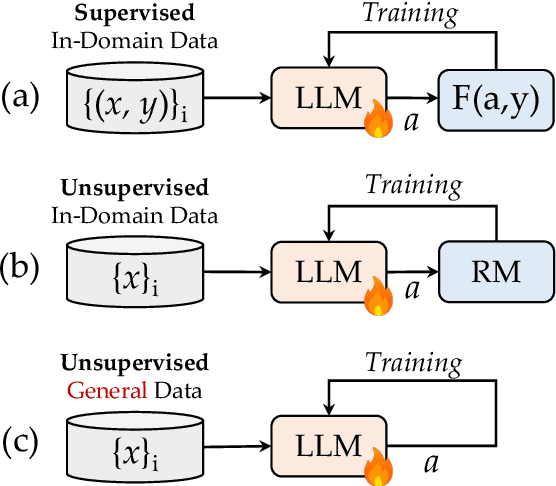
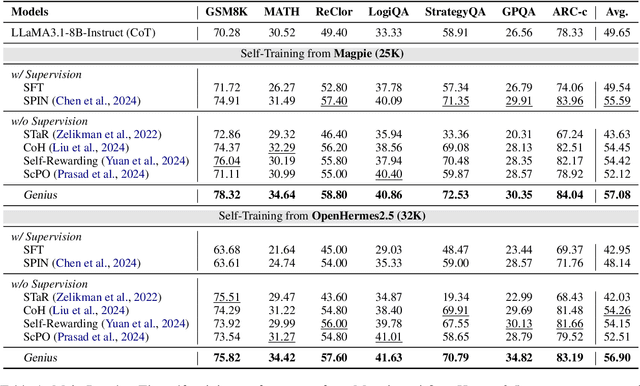


Abstract:Advancing LLM reasoning skills has captivated wide interest. However, current post-training techniques rely heavily on supervisory signals, such as outcome supervision or auxiliary reward models, which face the problem of scalability and high annotation costs. This motivates us to enhance LLM reasoning without the need for external supervision. We introduce a generalizable and purely unsupervised self-training framework, named Genius. Without external auxiliary, Genius requires to seek the optimal response sequence in a stepwise manner and optimize the LLM. To explore the potential steps and exploit the optimal ones, Genius introduces a stepwise foresight re-sampling strategy to sample and estimate the step value by simulating future outcomes. Further, we recognize that the unsupervised setting inevitably induces the intrinsic noise and uncertainty. To provide a robust optimization, we propose an advantage-calibrated optimization (ACO) loss function to mitigate estimation inconsistencies. Combining these techniques together, Genius provides an advanced initial step towards self-improve LLM reasoning with general queries and without supervision, revolutionizing reasoning scaling laws given the vast availability of general queries. The code will be released at https://github.com/xufangzhi/Genius.
CapArena: Benchmarking and Analyzing Detailed Image Captioning in the LLM Era
Mar 16, 2025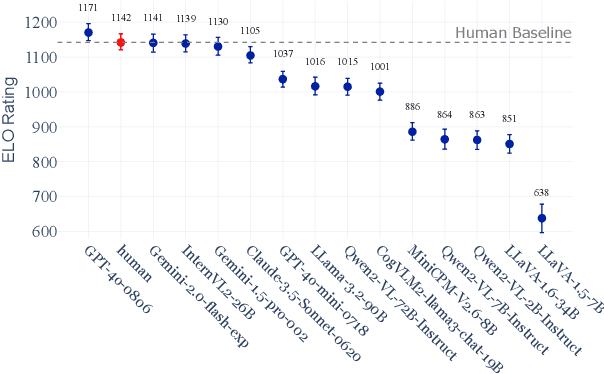
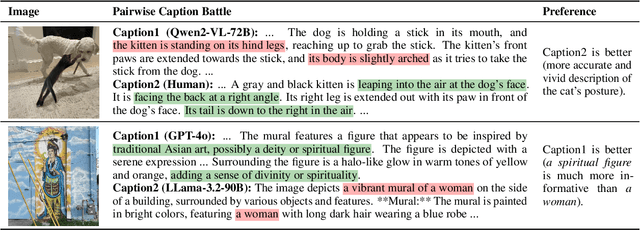
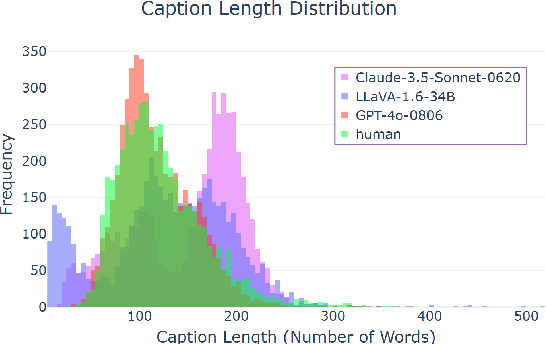
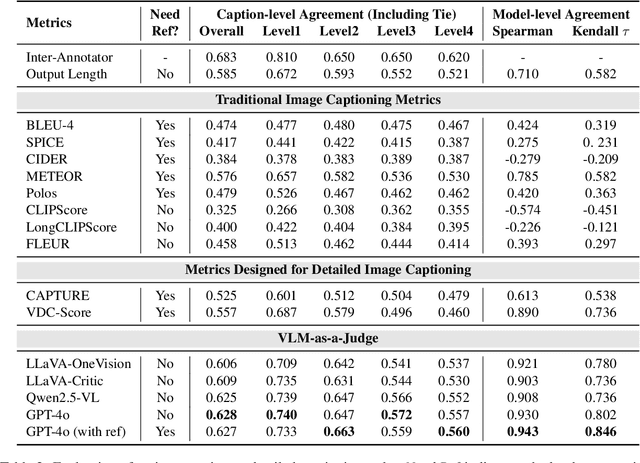
Abstract:Image captioning has been a longstanding challenge in vision-language research. With the rise of LLMs, modern Vision-Language Models (VLMs) generate detailed and comprehensive image descriptions. However, benchmarking the quality of such captions remains unresolved. This paper addresses two key questions: (1) How well do current VLMs actually perform on image captioning, particularly compared to humans? We built CapArena, a platform with over 6000 pairwise caption battles and high-quality human preference votes. Our arena-style evaluation marks a milestone, showing that leading models like GPT-4o achieve or even surpass human performance, while most open-source models lag behind. (2) Can automated metrics reliably assess detailed caption quality? Using human annotations from CapArena, we evaluate traditional and recent captioning metrics, as well as VLM-as-a-Judge. Our analysis reveals that while some metrics (e.g., METEOR) show decent caption-level agreement with humans, their systematic biases lead to inconsistencies in model ranking. In contrast, VLM-as-a-Judge demonstrates robust discernment at both the caption and model levels. Building on these insights, we release CapArena-Auto, an accurate and efficient automated benchmark for detailed captioning, achieving 94.3% correlation with human rankings at just $4 per test. Data and resources will be open-sourced at https://caparena.github.io.
OS-Genesis: Automating GUI Agent Trajectory Construction via Reverse Task Synthesis
Dec 27, 2024



Abstract:Graphical User Interface (GUI) agents powered by Vision-Language Models (VLMs) have demonstrated human-like computer control capability. Despite their utility in advancing digital automation, a critical bottleneck persists: collecting high-quality trajectory data for training. Common practices for collecting such data rely on human supervision or synthetic data generation through executing pre-defined tasks, which are either resource-intensive or unable to guarantee data quality. Moreover, these methods suffer from limited data diversity and significant gaps between synthetic data and real-world environments. To address these challenges, we propose OS-Genesis, a novel GUI data synthesis pipeline that reverses the conventional trajectory collection process. Instead of relying on pre-defined tasks, OS-Genesis enables agents first to perceive environments and perform step-wise interactions, then retrospectively derive high-quality tasks to enable trajectory-level exploration. A trajectory reward model is then employed to ensure the quality of the generated trajectories. We demonstrate that training GUI agents with OS-Genesis significantly improves their performance on highly challenging online benchmarks. In-depth analysis further validates OS-Genesis's efficiency and its superior data quality and diversity compared to existing synthesis methods. Our codes, data, and checkpoints are available at \href{https://qiushisun.github.io/OS-Genesis-Home/}{OS-Genesis Homepage}.
Vision-Language Models Can Self-Improve Reasoning via Reflection
Oct 30, 2024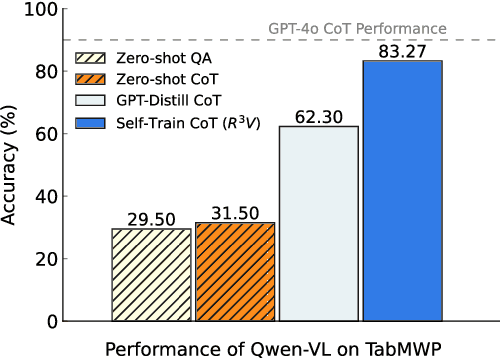
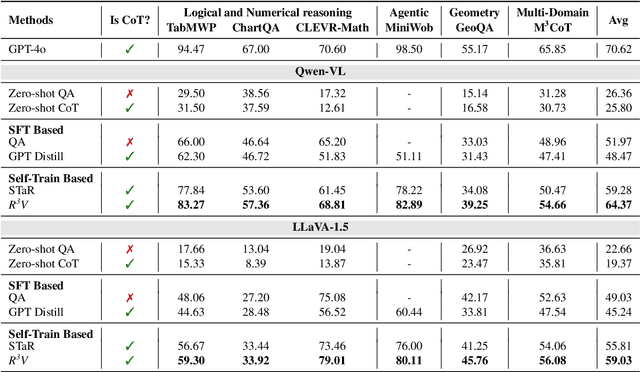
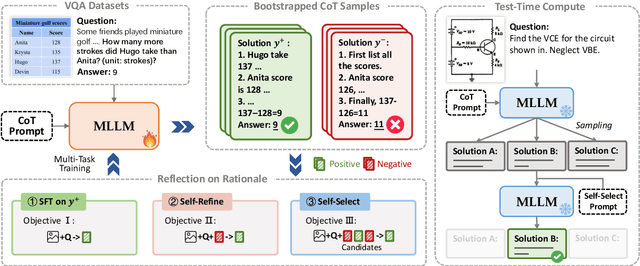
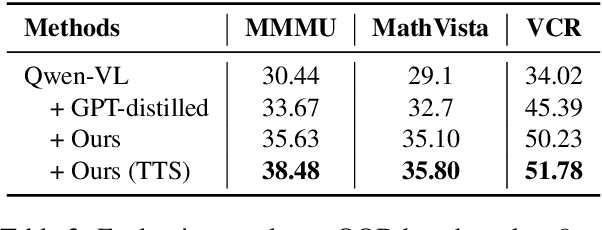
Abstract:Chain-of-thought (CoT) has proven to improve the reasoning capability of large language models (LLMs). However, due to the complexity of multimodal scenarios and the difficulty in collecting high-quality CoT data, CoT reasoning in multimodal LLMs has been largely overlooked. To this end, we propose a simple yet effective self-training framework, R3V, which iteratively enhances the model's Vision-language Reasoning by Reflecting on CoT Rationales. Our framework consists of two interleaved parts: (1) iteratively bootstrapping positive and negative solutions for reasoning datasets, and (2) reflection on rationale for learning from mistakes. Specifically, we introduce the self-refine and self-select losses, enabling the model to refine flawed rationale and derive the correct answer by comparing rationale candidates. Experiments on a wide range of vision-language tasks show that R3V consistently improves multimodal LLM reasoning, achieving a relative improvement of 23 to 60 percent over GPT-distilled baselines. Additionally, our approach supports self-reflection on generated solutions, further boosting performance through test-time computation.
OS-ATLAS: A Foundation Action Model for Generalist GUI Agents
Oct 30, 2024
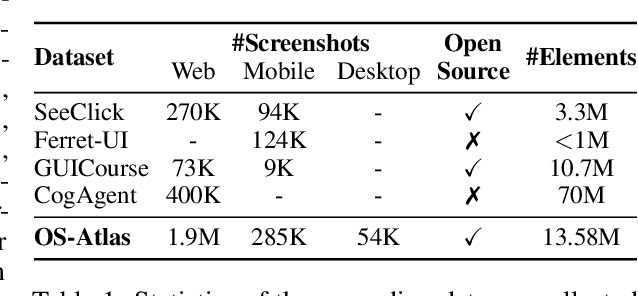
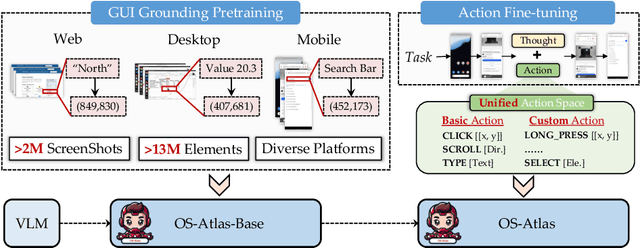
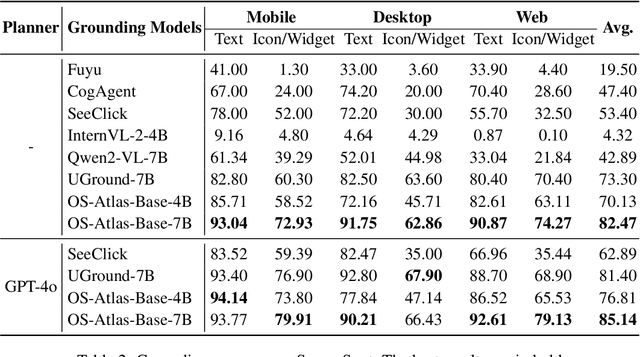
Abstract:Existing efforts in building GUI agents heavily rely on the availability of robust commercial Vision-Language Models (VLMs) such as GPT-4o and GeminiProVision. Practitioners are often reluctant to use open-source VLMs due to their significant performance lag compared to their closed-source counterparts, particularly in GUI grounding and Out-Of-Distribution (OOD) scenarios. To facilitate future research in this area, we developed OS-Atlas - a foundational GUI action model that excels at GUI grounding and OOD agentic tasks through innovations in both data and modeling. We have invested significant engineering effort in developing an open-source toolkit for synthesizing GUI grounding data across multiple platforms, including Windows, Linux, MacOS, Android, and the web. Leveraging this toolkit, we are releasing the largest open-source cross-platform GUI grounding corpus to date, which contains over 13 million GUI elements. This dataset, combined with innovations in model training, provides a solid foundation for OS-Atlas to understand GUI screenshots and generalize to unseen interfaces. Through extensive evaluation across six benchmarks spanning three different platforms (mobile, desktop, and web), OS-Atlas demonstrates significant performance improvements over previous state-of-the-art models. Our evaluation also uncovers valuable insights into continuously improving and scaling the agentic capabilities of open-source VLMs.
Interactive Evolution: A Neural-Symbolic Self-Training Framework For Large Language Models
Jun 17, 2024

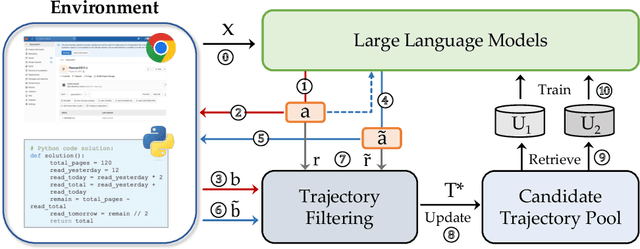
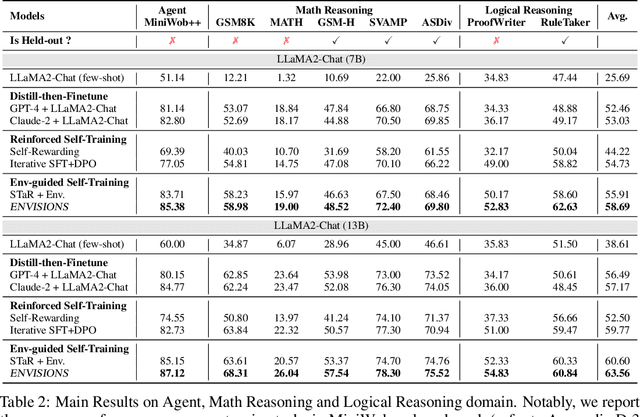
Abstract:One of the primary driving forces contributing to the superior performance of Large Language Models (LLMs) is the extensive availability of human-annotated natural language data, which is used for alignment fine-tuning. This inspired researchers to investigate self-training methods to mitigate the extensive reliance on human annotations. However, the current success of self-training has been primarily observed in natural language scenarios, rather than in the increasingly important neural-symbolic scenarios. To this end, we propose an environment-guided neural-symbolic self-training framework named ENVISIONS. It aims to overcome two main challenges: (1) the scarcity of symbolic data, and (2) the limited proficiency of LLMs in processing symbolic language. Extensive evaluations conducted on three distinct domains demonstrate the effectiveness of our approach. Additionally, we have conducted a comprehensive analysis to uncover the factors contributing to ENVISIONS's success, thereby offering valuable insights for future research in this area. Code will be available at \url{https://github.com/xufangzhi/ENVISIONS}.
A Survey of Neural Code Intelligence: Paradigms, Advances and Beyond
Mar 21, 2024Abstract:Neural Code Intelligence -- leveraging deep learning to understand, generate, and optimize code -- holds immense potential for transformative impacts on the whole society. Bridging the gap between Natural Language and Programming Language, this domain has drawn significant attention from researchers in both research communities over the past few years. This survey presents a systematic and chronological review of the advancements in code intelligence, encompassing over 50 representative models and their variants, more than 20 categories of tasks, and an extensive coverage of over 680 related works. We follow the historical progression to trace the paradigm shifts across different research phases (e.g., from modeling code with recurrent neural networks to the era of Large Language Models). Concurrently, we highlight the major technical transitions in models, tasks, and evaluations spanning through different stages. For applications, we also observe a co-evolving shift. It spans from initial endeavors to tackling specific scenarios, through exploring a diverse array of tasks during its rapid expansion, to currently focusing on tackling increasingly complex and varied real-world challenges. Building on our examination of the developmental trajectories, we further investigate the emerging synergies between code intelligence and broader machine intelligence, uncovering new cross-domain opportunities and illustrating the substantial influence of code intelligence across various domains. Finally, we delve into both the opportunities and challenges associated with this field, alongside elucidating our insights on the most promising research directions. An ongoing, dynamically updated project and resources associated with this survey have been released at https://github.com/QiushiSun/NCISurvey.
SeeClick: Harnessing GUI Grounding for Advanced Visual GUI Agents
Jan 17, 2024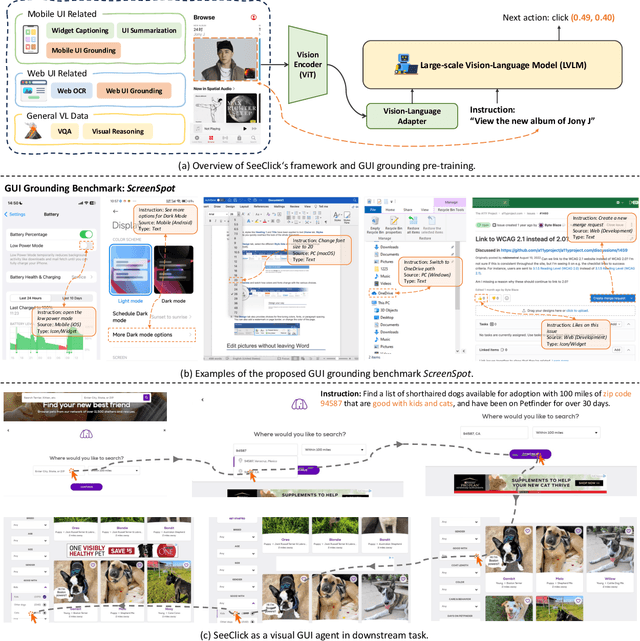

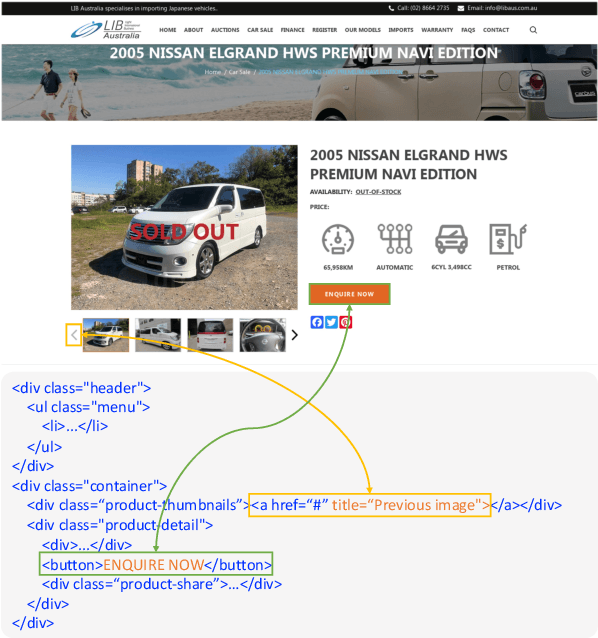
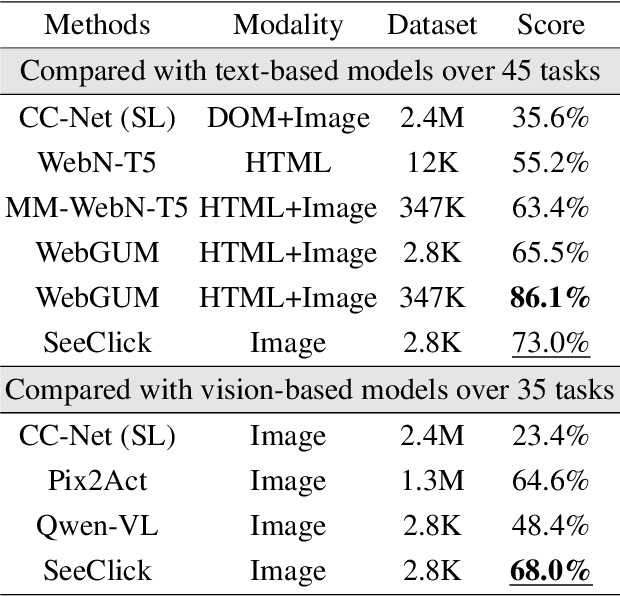
Abstract:Graphical User Interface (GUI) agents are designed to automate complex tasks on digital devices, such as smartphones and desktops. Most existing GUI agents interact with the environment through extracted structured data, which can be notably lengthy (e.g., HTML) and occasionally inaccessible (e.g., on desktops). To alleviate this issue, we propose a visual GUI agent -- SeeClick, which only relies on screenshots for task automation. In our preliminary study, we have discovered a key challenge in developing visual GUI agents: GUI grounding -- the capacity to accurately locate screen elements based on instructions. To tackle this challenge, we propose to enhance SeeClick with GUI grounding pre-training and devise a method to automate the curation of GUI grounding data. Along with the efforts above, we have also created ScreenSpot, the first realistic GUI grounding dataset that encompasses mobile, desktop, and web environments. After pre-training, SeeClick demonstrates significant improvement in ScreenSpot over various baselines. Moreover, comprehensive evaluations on three widely used benchmarks consistently support our finding that advancements in GUI grounding directly correlate with enhanced performance in downstream GUI agent tasks. The model, data and code are available at https://github.com/njucckevin/SeeClick.
Food-500 Cap: A Fine-Grained Food Caption Benchmark for Evaluating Vision-Language Models
Aug 06, 2023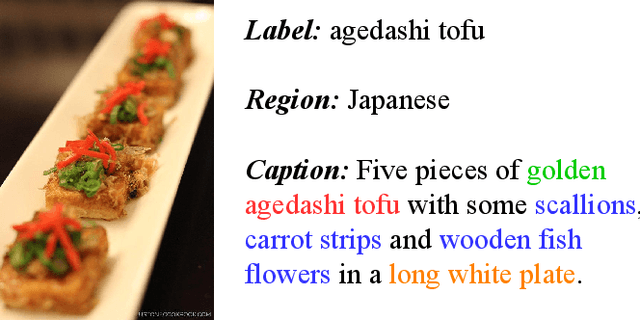
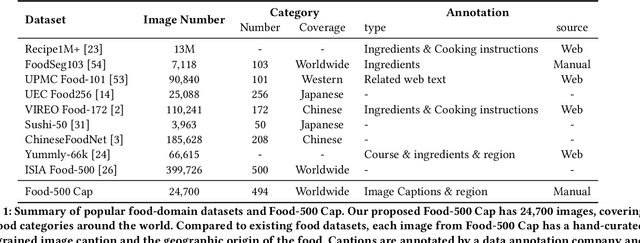
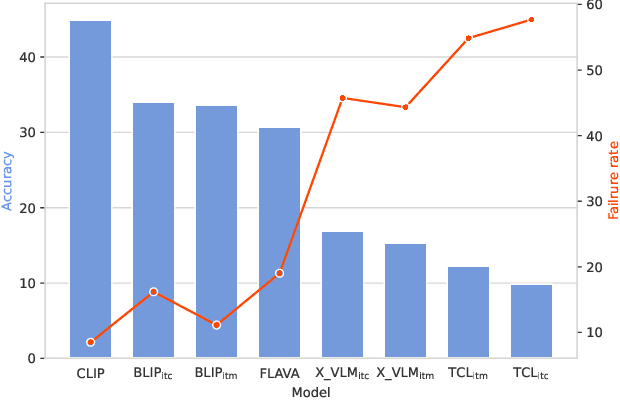
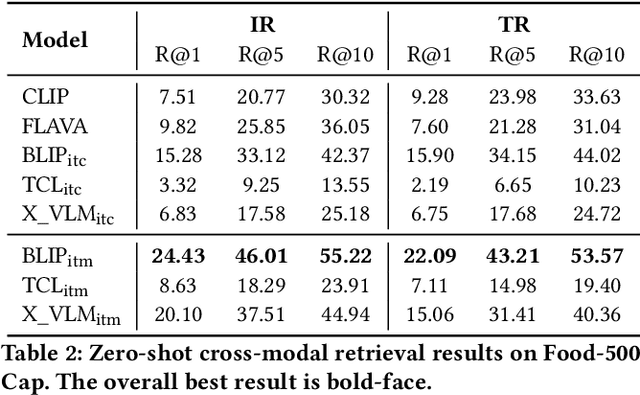
Abstract:Vision-language models (VLMs) have shown impressive performance in substantial downstream multi-modal tasks. However, only comparing the fine-tuned performance on downstream tasks leads to the poor interpretability of VLMs, which is adverse to their future improvement. Several prior works have identified this issue and used various probing methods under a zero-shot setting to detect VLMs' limitations, but they all examine VLMs using general datasets instead of specialized ones. In practical applications, VLMs are usually applied to specific scenarios, such as e-commerce and news fields, so the generalization of VLMs in specific domains should be given more attention. In this paper, we comprehensively investigate the capabilities of popular VLMs in a specific field, the food domain. To this end, we build a food caption dataset, Food-500 Cap, which contains 24,700 food images with 494 categories. Each image is accompanied by a detailed caption, including fine-grained attributes of food, such as the ingredient, shape, and color. We also provide a culinary culture taxonomy that classifies each food category based on its geographic origin in order to better analyze the performance differences of VLM in different regions. Experiments on our proposed datasets demonstrate that popular VLMs underperform in the food domain compared with their performance in the general domain. Furthermore, our research reveals severe bias in VLMs' ability to handle food items from different geographic regions. We adopt diverse probing methods and evaluate nine VLMs belonging to different architectures to verify the aforementioned observations. We hope that our study will bring researchers' attention to VLM's limitations when applying them to the domain of food or culinary cultures, and spur further investigations to address this issue.
 Add to Chrome
Add to Chrome Add to Firefox
Add to Firefox Add to Edge
Add to Edge